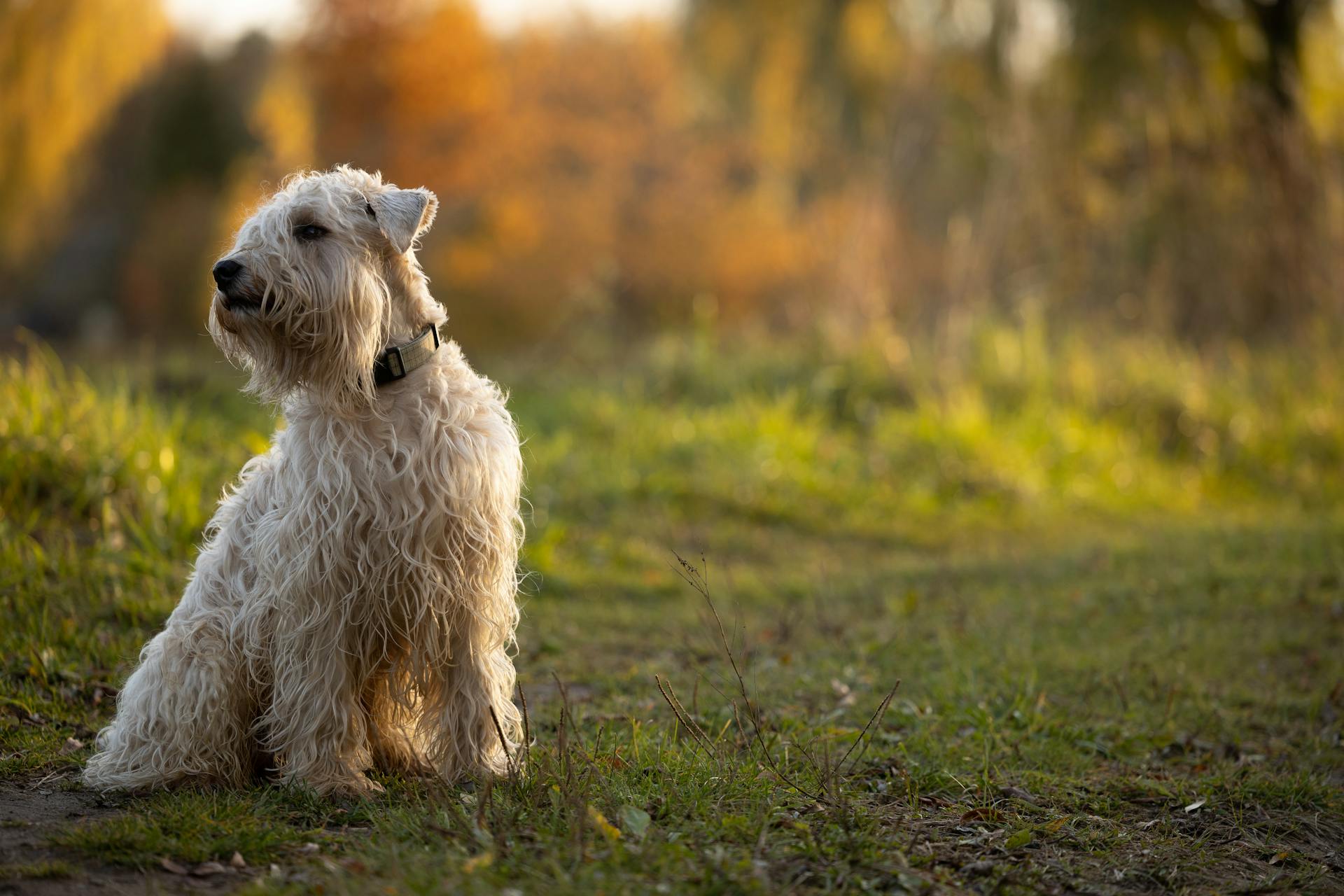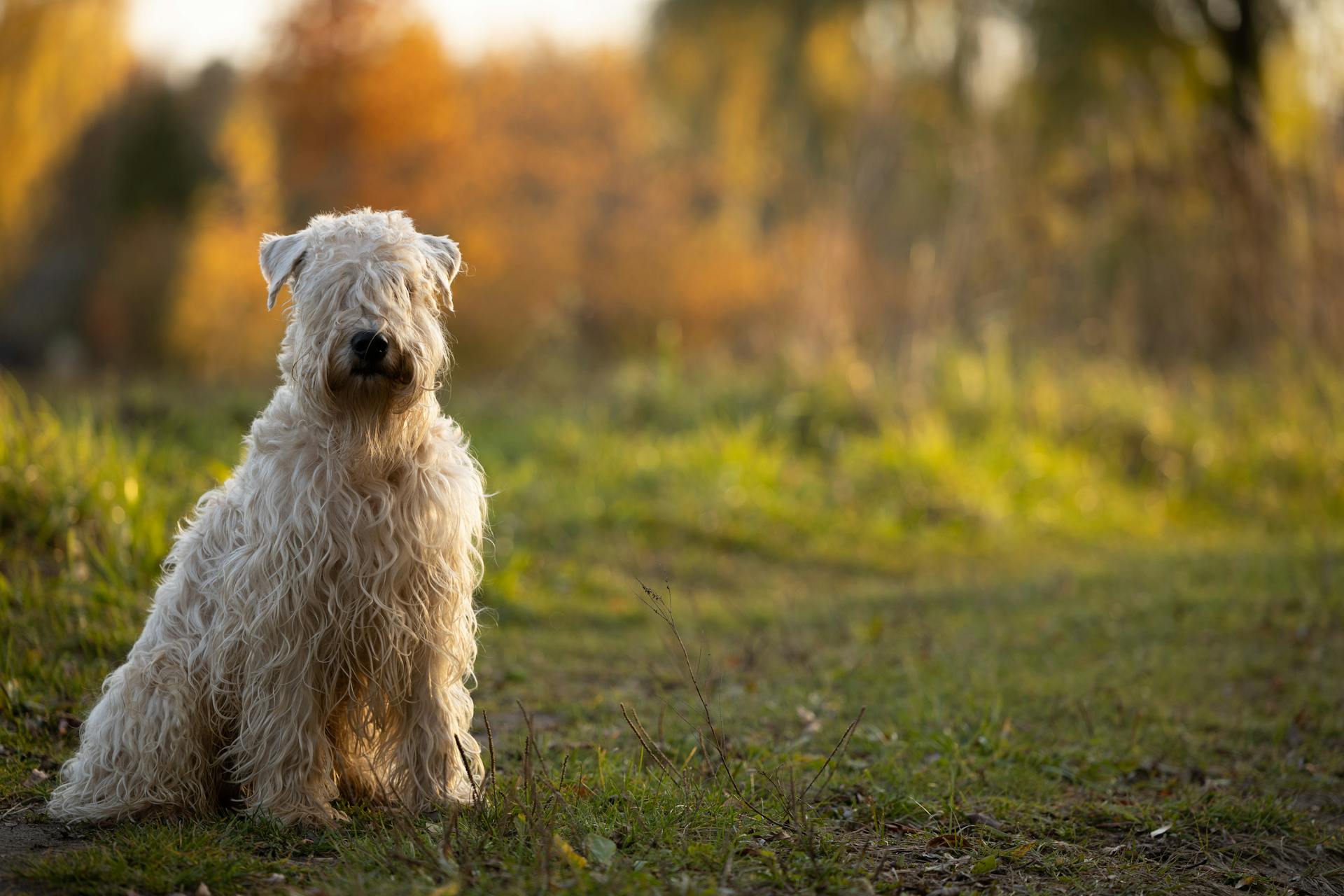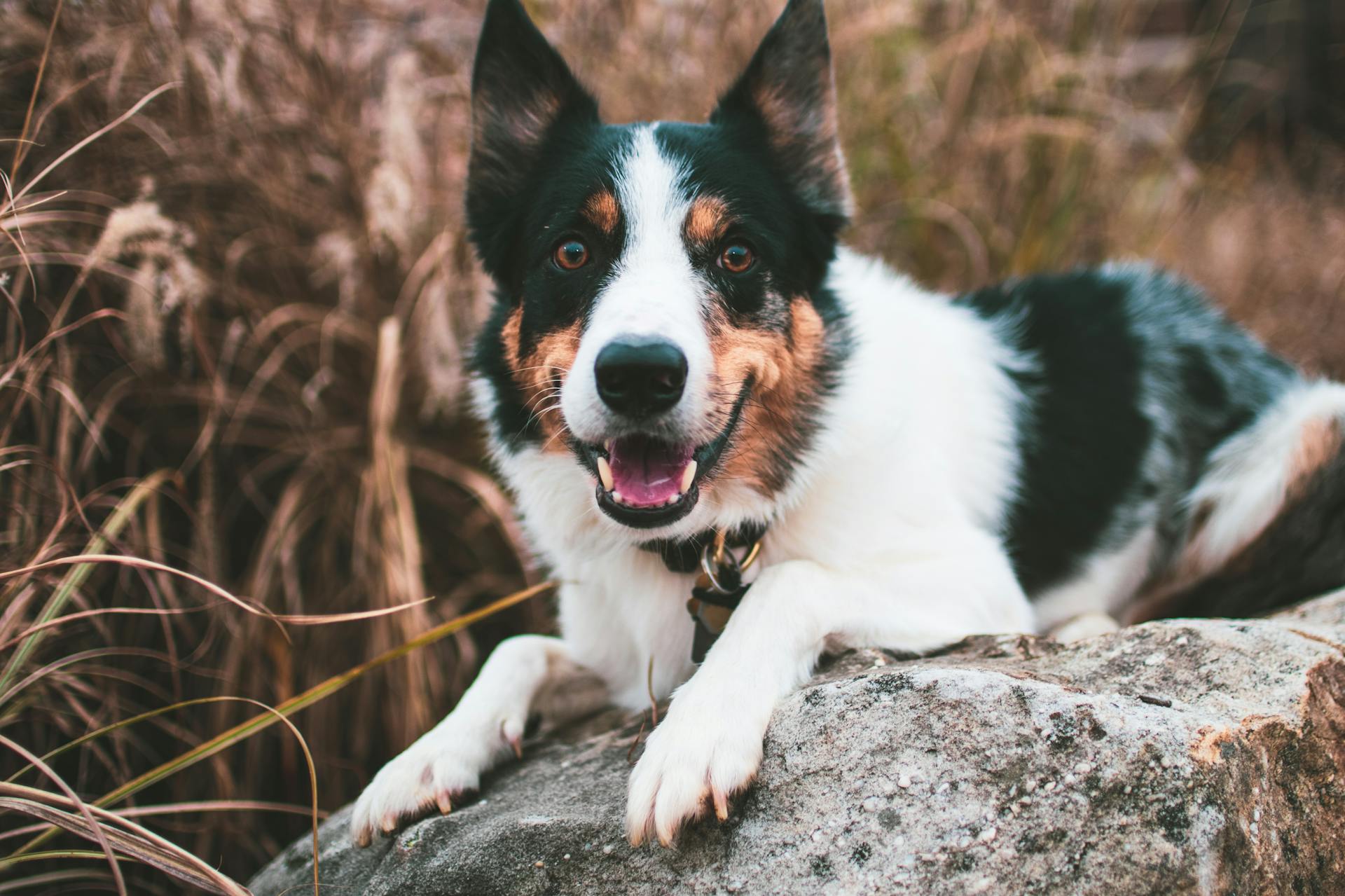
Border Terriers are a beloved breed known for their friendly and outgoing personalities. They originated in the Anglo-Scottish border region.
One of the most distinctive features of Border Terriers is their unique appearance - they have a sturdy build, short legs, and a broad head with a flat skull. Their coats come in a variety of colors including red, wheaten, black, and tan.
Border Terriers are relatively small dogs, typically weighing between 10-15 pounds and standing about 15 inches tall at the shoulder. They have a lifespan of around 12-14 years on average.
General Information
Border terriers are affectionate and friendly dogs that make great companions. They thrive on human interaction and love to be around their family members.
Their adaptable nature allows them to adjust easily to new environments and living situations, making them a popular choice for many owners.
While they can be strong-willed at times, consistent training and positive reinforcement can help shape their behavior and ensure they listen to commands.
Border terriers are energetic dogs that require regular exercise to stay happy and healthy. A daily walk or playtime in the yard is essential to keep them active and engaged.
Their high prey drive means they may not be suitable for households with small pets, such as hamsters or gerbils, unless proper precautions are taken to prevent interactions.
As prolific diggers, border terriers require a securely fenced yard to prevent escape attempts and damage to property.
Breed History and Origin
The Border Terrier breed originated in the border region between England and Scotland.
Their ancestors can be traced back to this area, where they were related to breeds like the Dandie Dinmont and Bedlington terrier.
In the 19th century, farmers in this region wanted a dog that was athletic, brave, intelligent, and driven to help catch and deter foxes that threatened their sheep.
The Border Terriers had to have long legs to keep up on the hunt but small bodies that would allow them to burrow into a fox’s den and flush it out.
They were originally bred to hunt small game like foxes and rabbits, and were prized for their tenacity and ability to work in harsh conditions.
The Kennel Club of the U.K. first recognized the breed in 1920, and the American Kennel Club followed suit in 1930.
Today, Border Terriers are still used for hunting but are also popular as family pets, appearing in films and television series like There’s Something About Mary and It’s Always Sunny in Philadelphia.
You might like: American Kennel Club Lancashire Heeler
Characteristics of the Border Terrier
Border terriers are loving dogs with a strong family bond, making them great companions for families with children when properly trained and socialized.
They're quite intelligent and moderately trainable, but can have a strong-willed streak to their personality.
These dogs love to play and are known for their high energy level, which is just right for an active family looking for a furry friend to join in on the fun.
Border terriers typically weigh between 11 and 16 pounds and stand about 10 to 11 inches tall at the shoulder.
Their wiry coat comes in a variety of colors, including red, blue, tan, and wheaten.
They have low shedding, making them a great choice for those with allergies or who prefer less dog hair around the house.
Here's a quick rundown of their characteristics:
Overall, border terriers are a wonderful breed for families who want a loving and playful companion.
Traits and Behavior
Border Terriers are people-oriented dogs and love to be around their family members.
They have a high prey drive, which means they'll chase smaller animals like cats, squirrels, rats, rabbits, and hamsters if not properly socialized at a young age.
These energetic dogs need plenty of exercise and mental stimulation to prevent boredom and destructive behavior.
Their friendly and outgoing personalities make them great family dogs suitable for both city and country living.
Border Terriers are known to be loyal and affectionate companions who will bring joy and laughter to any household.
They can easily become noisy, destructive, and unhappy if left too much to their own devices without proper attention and care.
To minimize shedding, Border Terriers need regular brushing or combing at least once a week.
With positive reinforcement training, they can be trained relatively easily but may be stubborn at times.
Health and Care
Border terriers are generally a healthy breed, but like all breeds, they can be prone to certain health issues.
Regular check-ups with your veterinarian are essential for monitoring their health and catching any potential problems early on.
To stay on top of their eye health, it's recommended that you schedule regular eye examinations. This will help detect conditions such as cataracts and retinal dysplasia.
In addition to eye exams, your vet may also recommend a Fanconi Urine Test, Blood And Urine Protein Screens, or other tests to ensure they're healthy.
A balanced diet, plenty of exercise, and regular grooming can go a long way in keeping your border terrier happy and healthy.
For another approach, see: Healthy Bull Terrier
Common Health Problems

Border Terriers are a relatively healthy breed, but like all breeds, they can be prone to certain health issues. Cataracts and retinal dysplasia are two common eye problems that can affect them.
Regular check-ups with your veterinarian are essential for monitoring your Border Terrier's health. A fanconi urine test, blood and urine protein screens, and an eye examination can help identify potential issues early on.
Hip dysplasia is a condition where the hip joint doesn't form properly, leading to arthritis and mobility problems. Heart disease is another serious issue that can affect Border Terriers, and it's essential to have your dog checked for it regularly.
Eye problems are common in Border Terriers, including progressive retinal atrophy and juvenile cataracts. Seizures can also occur due to a seizure-like disorder called canine epileptoid cramping syndrome (CECS), which has no genetic screening test yet.
If you suspect that your Border Terrier is experiencing any of these health issues, it's crucial to consult with your veterinarian promptly. They can provide guidance on the best course of action and help you manage your dog's condition effectively.
For more insights, see: English Bulldog Dermatitis
Health and Vaccinations

Regular veterinary check-ups are crucial for your puppy's health. They can help catch any health issues early.
Vaccinations protect against common diseases and illnesses in Border Terriers. These vaccinations should be a priority when bringing home a new puppy.
Medical expenses can add up quickly, so it is essential to consider pet insurance to help cover the costs of unexpected illnesses or injuries.
Here are some medical tests that are recommended for Border Terriers:
- Fanconi Urine Test
- Blood And Urine Protein Screens
- Eye Examination
These tests can help identify potential health issues, such as cataracts and retinal dysplasia.
Teeth
Brushing your pet's teeth is crucial for their oral health.
Some dogs are prone to dental problems and sensitive teeth, especially small dogs with tiny teeth.
Gum disease caused by tartar buildup is a common issue in dogs, not cavities.
Daily brushing is ideal but doing so on a weekly basis can still make a big difference.
This regular brushing will help avoid the need for a veterinarian cleaning, which often requires sedation.
You might like: English Bulldog Teeth
Puppy Care
Border terriers need quite a bit of exercise and playtime to be happy and healthy.
Regular veterinary check-ups are crucial for your puppy's health, so schedule visits at least twice a year.
Their grooming is fairly easy, though it becomes more involved during their shedding season.
Medical expenses can add up quickly, so it's essential to consider pet insurance to help cover the costs of unexpected illnesses or injuries.
Grooming and Maintenance
Border Terriers have a wiry coat that sheds minimally.
Brushing their coat once or twice a week can help prevent matting and tangling.
Bathing should be done as needed, using a mild shampoo specifically formulated for dogs.
Regular nail trimming is essential to keep your Border Terrier's nails from getting too long.
You'll want to check your dog's nails roughly once a month to see whether they need trimming.
The coat of border terriers is naturally effective at repelling dirt, and baths can actually hinder this ability.
Daily brushing will help distribute oils in the coat, but it won't be enough during periods of higher shedding twice a year.
During these times, you'll have to manually strip the loose fur from the coat on a daily basis with a rake or special stripping tool.
Exercise and Play
Border terriers are energetic and active dogs that require regular exercise and playtime to stay healthy and happy.
Daily walks are essential for border terriers, and they generally love brisk walks, jogging, hikes, and playing fetch.
Playing fetch is a great way to keep your border terrier engaged and active, helping to strengthen the bond between you and your pet.
Border terriers also excel in dog sports like agility, flyball, and tracking, which provide excellent mental stimulation as well as physical activity.
These athletic canines will quickly take off chasing their quarry due to their high prey drive, so always keep them on a leash or in a secure area for exercise.
Make sure any fencing extends underground deep enough that they can't get under it, as border terriers are skilled diggers.
Training and Nutrition
Training your border terrier is essential for their well-being and your relationship with them.
Start training as early as possible, ideally from puppyhood, to establish good habits before bad ones form. Consistency is key, so be sure to use positive reinforcement methods and avoid harsh corrections.
Border terriers are adaptable and open to meeting new people and dogs if they've had positive experiences from a young age. However, their strong prey drive can make them poor companions for other household pets.
A well-balanced diet is crucial for your border terrier's physical and mental health. Provide high-quality dog food that meets their nutritional needs, and consider adding puzzle toys or interactive games to keep them mentally stimulated and prevent boredom.
Basic Training Principles
Border terriers are bright and eager to please, making them adept at learning obedience commands. They thrive on positive reinforcement, so always use rewards for good behavior.
Training should start as early as possible, ideally with a puppy obedience class from a young age. Consistency is key when teaching your border terrier new skills.
Harsh corrections can cause a dog to shut down and not learn, so it's essential to be patient and gentle during training sessions. Praise and rewards should be given for good behavior, and punishment should be avoided.
Worth a look: Alaskan Malamute Behavior

Introducing your dog to different people, other dogs, and various environments from an early age is crucial for their socialization and adaptability. This breed typically adapts well to new situations if they've had positive experiences.
Border terriers are highly trainable dogs that excel in competitions like agility and obedience. To prepare them for these events, start training at a young age and work with a qualified trainer who uses positive reinforcement techniques.
Providing your border terrier with plenty of exercise, playtime, and mental stimulation is essential for their physical and mental well-being. Engage them with puzzles, toys, and games to prevent boredom and keep their minds active.
Diet and Nutrition
Feed your Border Terrier two measured meals per day for optimal nutrition.
A high-quality, nutritionally balanced canine diet is essential for their overall health and well-being.
Most owners choose a commercial puppy food that contains all necessary nutrients in the correct proportions.
Treats should be given sparingly to prevent overeating and obesity.
Discuss your dog's specific dietary needs with your vet, as they can vary based on age, activity level, and other factors.
Remember to factor treats and other extra food into your dog’s daily intake to maintain a balanced diet.
You might like: Yorkshire Terrier Treats
Frequently Asked Questions
Do Border Terriers like to cuddle?
Border Terriers enjoy physical closeness with their owners, but may not always want to be held or cuddled in a traditional sense. They often prefer affection on their own terms, such as nuzzling and leaning against their owner.
Is a Border Terrier a good family dog?
Yes, Border Terriers are a great choice for families due to their energetic and even-tempered nature. They thrive in households with children and other pets when introduced properly.
Are Border Terriers barkers?
Border Terriers are not big barkers, but they will alert you when someone is at the door. They're generally quiet, but vocal enough to let you know what's going on.
What is a Border Terrier a mix of?
A Border Terrier is a mix of breeds related to the Bedlington Terrier and Dandie Dinmont Terrier. Its unique ancestry makes it an interesting breed with a rich history.
Do Border Terriers ever calm down?
Border Terriers typically calm down around 2 years old as they fully mature. With patience and proper training, your Border Terrier can become a well-behaved companion.
Sources
- https://wagwalking.com/breed/border-terrier
- https://www.thesprucepets.com/border-terrier-dog-breed-profile-4780473
- https://blog.tryfi.com/how-much-are-border-terrier-puppies/
- https://www.embracepetinsurance.com/dog-breeds/border-terrier
- https://wahlusa.com/pet-grooming/product-selector/dog/border-terrier
Featured Images: pexels.com


